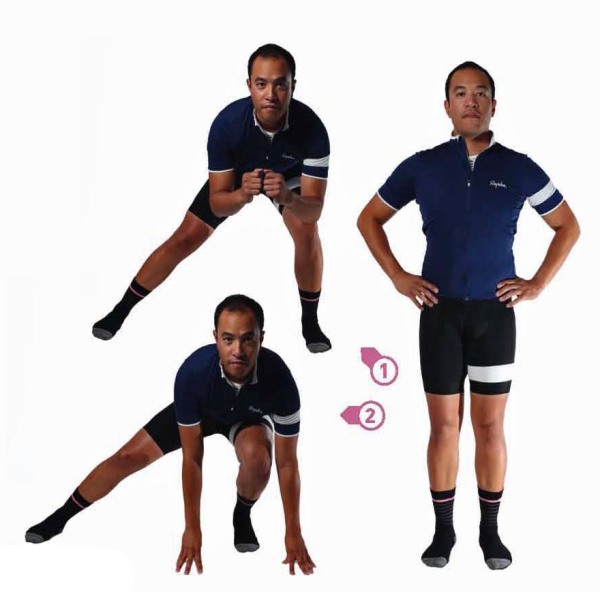It’s hard to beat lunges for a lower-body warm up. Simon Vincett suggests this set you can do before any ride.

The basic lunge is a superb exercise for warming up the major cycling muscles of the thighs and buttocks. With a few lunge variations as well, you can wake up the supporting muscles too, priming your whole lower body for getting active.
These lunges are ideal to do before a ride—perhaps while waiting for riding mates—or as a quick workout on their own. As a warm up, keep it dynamic, moving into and out of the lunges with a nice flow. For fun and to warm up the body a bit more, incorporate some upper body movement with sets touching the ground or lifting the arms high.
With all the lunges, hold your torso tall, with your shoulders back and core engaged. For the basic lunge and some of the variations, holding a broomstick or barbell across the top of your shoulders behind your neck is a great way to encourage good alignment in your torso.
You need to take care of your knees with lunges. They need to stay vertically above the ankle to prevent straining them. If you have any pain in your knees, take shorter steps. This should prevent the knees going out of alignment. With practice will come strength and you can start taking a longer step.
Basic lunge

Take a big step forward and let your back knee release toward the ground. Keep your front knee directly above the ankle of the front foot by drawing your knee back. Take a longer step if you need to or don’t lunge as deeply. Your knee shouldn’t sway out to the side but should be vertically above the ankle. For maximum difficulty, let your back knee come lightly to the ground.
Do five lunges each side with your body upright (Fig 1); then five each side where you come forward and touch the ground either side of your front foot (Fig 2); and finally do five each side where you reach up with your fingertips as you lunge (Fig 3).
Back lunge

This is the same as the basic lunge but you step back to go into the lunge. Some people find this version a little easier on their knees. It’s also worthwhile to get the body doing something different from moving forward all the time.
Do five each side with the body upright (Fig 1); then five each side of both variations of the basic lunge, with a set touching the ground (Fig 2) and a set reaching up (Fig 3).
Lunge and lift

Now we add another step to the basic lunge. Step forward and complete the lunge (Fig 1), then bring the back leg all the way through to your chest as you stand up on the front leg. Hug the leg into your chest briefly (Fig 2) before releasing to standing.
Do five of these for each side.
Side lunge

Add a bit of lateral movement to your exercise. To keep the major riding muscles on track, it’s vital that we keep the supporting muscles strong and doing their job.
Step to the side and squat (Fig 1). Aim to have the outside edges of the feet parallel and to keep the leg of the anchored foot straight. You’ll lean forward a bit but try to keep your torso long and straight while you’re doing this. If the groin stretch on the inner leg is a bit strong, take a shorter step.
Do five for each side and then try another five each side where you reach down to touch the ground either side of the foot you stepped out with (Fig 2).
Diagonal lunge

Now that you’re warmed up a bit we can introduce a twist. Step diagonally backwards about 45 degrees (Fig 1). Have your toes pointing the way you’re facing and lunge, keeping the leg of the anchored foot straight. Keep your knee vertically above the ankle of the extended foot. If that’s too hard, try stepping more to the side (Fig 2) than back and taking a shorter step.
Do five for each side and then try another five each side where you reach down to touch the ground either side of the foot you stepped out with.
Walking squat

Finally, let’s concentrate again on those major muscles but get them working through their full range of motion. We don’t fully utilise our thigh and buttock muscles when riding, which can encourage them to shorten and tighten. Some deep squats can help to engage and strengthen these power players to be effective through their whole length, which has been shown to improve the performance of any operation of the muscles.
Step to the side and squat (Fig 1), keeping the shoulders back and the torso tall. Stand up (Fig 2), bringing the feet together and repeat (Fig 3 & 4). Squat as deeply as you can without your back starting to hunch over. Holding a broomstick or barbell across the top of your shoulders behind your neck is a great way to encourage good alignment in your torso.
Do ten repetitions.
For the best program for your individual needs, see your doctor or a fitness professional.
Looking for more stretches? Try these:
Stretches: a post-ride treat for your muscles
Warm up with dynamic stretches
Ride On content is editorially independent, but is supported financially by members of Bicycle Network. If you enjoy our articles and want to support the future publication of high-quality content, please consider helping out by becoming a member.

The link in your Ride On eMag for this post takes me to an old blog post (this one http://rideons.wordpress.com/2014/03/28/everything-old-is-new-again/). Tried to find an email address to tell you but nothing obvious.
Thanks for letting us know, Ben, and sorry about the mix up.